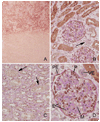Multiple superoxide dismutase 1/splicing factor serine alanine 15 variants are associated with the development and progression of diabetic nephropathy: the Diabetes Control and Complications Trial/Epidemiology of Diabetes Interventions and Complications Genetics study
- PMID: 17914031
- PMCID: PMC2655325
- DOI: 10.2337/db07-1059
Multiple superoxide dismutase 1/splicing factor serine alanine 15 variants are associated with the development and progression of diabetic nephropathy: the Diabetes Control and Complications Trial/Epidemiology of Diabetes Interventions and Complications Genetics study
Abstract
Background: Despite familial clustering of nephropathy and retinopathy severity in type 1 diabetes, few gene variants have been consistently associated with these outcomes.
Research design and methods: We performed an individual-based genetic association study with time to renal and retinal outcomes in 1,362 white probands with type 1 diabetes from the Diabetes Control and Complications Trial/Epidemiology of Diabetes Interventions and Complications (DCCT/EDIC) study. Specifically, we genotyped 1,411 SNPs that capture common variations in 212 candidate genes for long-term complications and analyzed them for association with the time from DCCT baseline to event for renal and retinal outcomes using multivariate Cox proportion hazards models. To address multiple testing and assist interpretation of the results, false discovery rate q values were calculated separately for each outcome.
Results: We observed association between rs17880135 in the 3' region of superoxide dismutase 1 (SOD1) and the incidence of both severe nephropathy (hazard ratio [HR] 2.62 [95% CI 1.64-4.18], P = 5.6 x 10(-5), q = 0.06) and persistent microalbuminuria (1.82 [1.29-2.57], P = 6.4 x 10(-4), q = 0.46). Sequencing and fine-mapping identified additional SOD1 variants, including rs202446, rs9974610, and rs204732, which were also associated (P < 10(-3)) with persistent microalbuminuria, whereas rs17880135 and rs17881180 were similarly associated with the development of severe nephropathy. Attempts to replicate the findings in three cross-sectional case-control studies produced equivocal results. We observed no striking differences between risk genotypes in serum SOD activity, serum SOD1 mass, or SOD1 mRNA expression in lymphoblastoid cell lines.
Conclusions: Multiple variations in SOD1 are significantly associated with persistent microalbuminuria and severe nephropathy in the DCCT/EDIC study.
Figures



References
-
- Seaquist ER, Goetz FC, Rich S, Barbosa J. Familial clustering of diabetic kidney disease: evidence for genetic susceptibility to diabetic nephropathy. N Engl J Med. 1989;320:1161–1165. - PubMed
-
- Borch-Johnsen K, Norgaard K, Hommel E, Mathiesen ER, Jensen JS, Deckert T, Parving HH. Is diabetic nephropathy an inherited complication? Kidney Int. 1992;41:719–722. - PubMed
-
- Quinn M, Angelico MC, Warram JH, Krolewski AS. Familial factors determine the development of diabetic nephropathy in patients with IDDM. Diabetologia. 1996;39:940–945. - PubMed
-
- The Diabetes Control and Complications Trial Research Group. Clustering of long-term complications in families with diabetes in the Diabetes Control and Complications Trial. Diabetes. 1997;46:1829–1839. - PubMed
-
- Harjutsalo V, Katoh S, Sarti C, Tajima N, Tuomilehto J. Population-based assessment of familial clustering of diabetic nephropathy in type 1 diabetes. Diabetes. 2004;53:2449–2454. - PubMed
Publication types
MeSH terms
Substances
Grants and funding
LinkOut - more resources
Full Text Sources
Medical
Molecular Biology Databases
Miscellaneous

